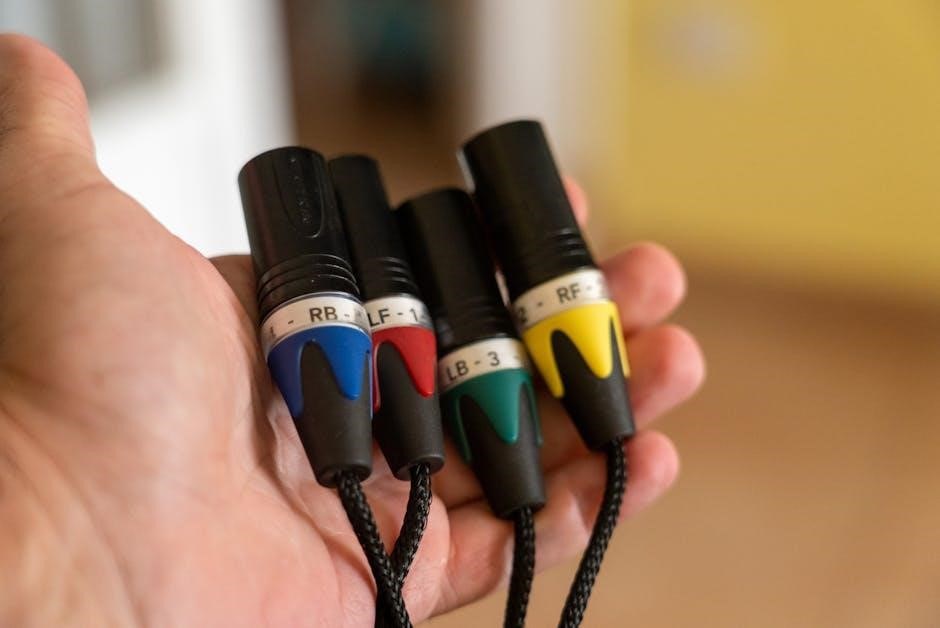Welcome to the Ribu1c Installation Manual, your comprehensive guide for safe and efficient relay setup. This manual offers step-by-step instructions, ensuring a smooth installation process for professionals and DIYers alike. With a focus on safety and optimal performance, it provides everything needed for a seamless Ribu1c experience.
What is the Ribu1c Relay?
The Ribu1c Relay is a high-performance, versatile SPDT (Single Pole Double Throw) pilot relay designed for efficient control systems. It is enclosed in a durable housing, integrating essential components like an LED indicator, socket, and transient protection, eliminating the need for separate installations; This relay is ideal for applications requiring robust switching capabilities, such as HVAC systems, lighting controls, and thermostat integration. With a 10 Amp rating, it supports diverse voltage requirements, making it suitable for both residential and commercial use. Its compact design and user-friendly configuration simplify installation, while its high-grade durability ensures long-term reliability. The Ribu1c Relay is a cost-effective, all-in-one solution for streamlined control system setups.
Importance of Proper Installation

Proper installation of the Ribu1c Relay is crucial to ensure safety, functionality, and efficiency. Incorrect wiring or setup can lead to electrical hazards, relay malfunction, or system failure. A well-executed installation prevents overheating, noise issues, and premature wear, ensuring reliable performance. It also guarantees compliance with electrical standards, reducing the risk of fire or shock. Proper installation maximizes energy efficiency and extends the lifespan of the relay. By following the manual’s guidelines, users can avoid common mistakes and ensure seamless integration with systems like thermostats or HVAC controls. This attention to detail safeguards both the device and the entire system, providing long-term reliability and optimal operation.

Technical Specifications of the Ribu1c Relay
The Ribu1c is a 10 Amp SPDT relay, offering versatile control for diverse applications. Its robust design supports a wide voltage range, ensuring compatibility with various electrical systems.
Electrical Ratings and Compatibility
The Ribu1c relay is rated for 10 Amps, ensuring reliable performance across a wide range of applications. It supports a voltage range of 10-30 Vac/dc and 208-277 Vac, making it compatible with both residential and commercial systems. Designed for versatility, the relay operates efficiently with HVAC systems, thermostats, and home automation devices. Its SPDT configuration allows for precise control of electrical circuits, ensuring safety and efficiency. The Ribu1c is compatible with standard wiring setups and integrates seamlessly with modern smart home systems. Always ensure the relay is used within its rated specifications to avoid damage or malfunction. Proper installation and adherence to electrical standards are crucial for optimal performance and long-term reliability.
Relay Configuration and Type (SPDT)
The Ribu1c relay operates as a Single Pole Double Throw (SPDT) device, enabling it to connect to two separate circuits simultaneously. This configuration allows for efficient switching between two loads, making it ideal for applications requiring precise control, such as HVAC systems or smart home devices. The SPDT design ensures that the relay can handle diverse electrical demands while maintaining reliable performance.
With its 10 Amp capacity, the Ribu1c SPDT relay is suitable for a wide range of applications, from residential to light commercial use. Its compact design and robust configuration make it a versatile solution for control systems. The relay’s SPDT functionality simplifies wiring and enhances system flexibility, ensuring smooth operation in various environments. This configuration is particularly beneficial for installations requiring multiple control points or dual-functionality, making it a preferred choice for both professionals and DIY enthusiasts.
Applications and Use Cases
The Ribu1c relay is versatile and widely used in various control systems, making it ideal for applications requiring precise switching. Its SPDT configuration allows it to efficiently manage dual circuits, making it a popular choice for HVAC systems, smart home devices, and industrial automation. Whether controlling a 120V indoor blower fan or integrating with thermostats like Nest or Honeywell, the Ribu1c delivers reliable performance. Its compact design and robust configuration also make it suitable for zone valve control in heating systems and lighting setups requiring motion detectors or timers.
Additionally, the Ribu1c is commonly used in commercial settings for managing large-scale electrical systems. Its high-grade durability and 10 Amp capacity ensure it can handle demanding environments. This relay is a go-to solution for professionals and DIY enthusiasts alike, offering flexibility and efficiency across a broad range of applications. Its user-friendly design and compatibility with modern control systems make it an essential component for seamless electrical management.
Key Features and Benefits
The Ribu1c relay stands out for its high performance and versatility, making it a reliable choice for various control systems. Its 10 Amp SPDT configuration ensures robust switching capabilities, suitable for diverse applications. The all-in-one design includes a relay, LED indicator, socket, and transient protection, simplifying installation and reducing costs. This relay boasts superior durability and protection, ensuring long-term reliability in demanding environments. Its user-friendly format and comprehensive documentation make it accessible for professionals and DIY enthusiasts alike. With a focus on safety and efficiency, the Ribu1c is ideal for HVAC systems, smart home devices, and industrial automation. Its compatibility with modern thermostats and control systems enhances its versatility, making it a cost-effective and efficient solution for seamless electrical management.

Pre-Installation Checks and Preparation
Ensure all tools and materials are ready. Verify electrical ratings and compatibility. Review wiring diagrams and safety guidelines. Prepare the installation area for a safe and efficient setup.
Tools and Materials Required
To install the Ribu1c relay, gather essential tools: screwdrivers, wire strippers, pliers, multimeter, and drill. Materials needed include wires (14-18 AWG), connectors, and mounting hardware. Ensure a safe environment with gloves and safety goggles. Refer to the wiring diagram for specific connections. Having a DIN rail or enclosure may be necessary for certain setups. Verify all components are compatible with the relay’s electrical ratings. Proper preparation ensures a smooth and efficient installation process. Double-check the wiring diagram to confirm the correct tools and materials for your application. This step is crucial for a successful and safe Ribu1c relay installation. Always follow safety guidelines when handling electrical components.
Understanding the Wiring Diagram
The wiring diagram is a critical component of the Ribu1c installation process. It provides a visual representation of the relay’s connections, ensuring correct wire placement. Familiarize yourself with the symbols and labels, which indicate terminals, power sources, and load connections. Pay attention to the SPDT configuration, as it determines how the relay switches between circuits. Correctly identifying the coil terminals (A1 and A2) is essential for proper operation. The diagram also highlights the importance of the C terminal when integrating with thermostats like Nest or Honeywell. Misinterpreting the wiring diagram can lead to common mistakes such as incorrect voltage connections or reversed polarity. Always cross-reference the diagram with your system’s specifications to ensure compatibility and safety. This step ensures a reliable and efficient setup for your Ribu1c relay.
Safety Precautions and Guidelines
Safety is paramount when installing the Ribu1c relay. Always disconnect power before starting work to avoid electrical shock or injury. Use insulated tools to handle live wires and ensure proper grounding of all components. Never overload circuits, as this can cause overheating or damage. Wear protective gear, including gloves and safety glasses, when working with electrical systems. Ensure the relay is mounted in a well-ventilated area to prevent heat buildup. Avoid touching electrical components with bare hands, as static discharge can damage the relay. Follow local electrical codes and manufacturer guidelines strictly. Proper insulation of wires and connections is essential to prevent short circuits. If unsure about any step, consult a licensed electrician. Adhering to these precautions ensures a safe and reliable installation process.

Step-by-Step Installation Process
Mount the Ribu1c relay securely, connect wires according to the wiring diagram, and test functionality to ensure proper operation. Follow each step carefully for a seamless setup and reliable performance.
MOUNTING THE RELAY
To ensure secure installation, mount the Ribu1c relay in a well-ventilated area, away from direct sunlight and moisture. Use the provided DIN rail clip or suitable mounting hardware to fasten the relay firmly. Ensure the relay is level and properly aligned on the DIN rail to prevent misalignment. Tighten screws according to the torque specifications to avoid damaging the terminals. For wall mounting, attach the relay to a sturdy surface using screws and wall anchors. Double-check the mounting for stability and proper alignment before proceeding. A secure mount ensures reliable performance and prevents potential damage from vibrations or movement. Always refer to the manual for specific mounting recommendations.
CONNECTING THE WIRES
For proper operation, connect the Ribu1c relay wires according to the wiring diagram. Use the correct gauge wires to ensure reliable connections. Strip insulation from the ends of the wires and secure them firmly to the relay terminals. Connect the line voltage (120V/220V) to terminals A and B, and the load (e.g., HVAC system) to terminals C and D. Ensure all connections are tight and free from loose strands. Double-check the wiring configuration to match your application, such as SPDT setups. Use a voltage tester to confirm power is applied correctly. Avoid reversing polarity to prevent damage. Secure any excess wire neatly to maintain a clean installation. Proper wiring ensures safe and efficient relay operation. Always refer to the wiring diagram for specific configurations and verify connections before powering up the system.
TESTING THE RELAY OPERATION
After completing the wiring connections, test the Ribu1c relay to ensure proper operation. Start by powering on the system and checking if the relay activates when the thermostat calls for heat or cooling. Use a multimeter to verify voltage at the relay terminals. Listen for the distinct “click” sound when the relay switches states. Confirm that the load (e.g., HVAC system or blower fan) turns on and off accordingly. Test both NO (normally open) and NC (normally closed) configurations to ensure functionality. If the relay fails to activate, check for loose connections or incorrect wiring. Repeat the test cycle several times to confirm reliability. Always ensure the system is powered off before making any adjustments. Proper testing ensures the relay operates as intended, providing reliable control for your system.

Wiring Diagrams and Configurations
This section provides detailed wiring diagrams and configurations for various applications, ensuring proper setup and connectivity for optimal performance and safety in different electrical systems and setups.
Standard Wiring Setup for HVAC Systems
The standard wiring setup for HVAC systems using the Ribu1c relay involves connecting the relay to your thermostat and HVAC unit; Ensure the relay is properly grounded and insulated. Connect the C-terminal from your thermostat to the relay’s common terminal. For 24V systems, wire the R-terminal to the relay’s coil terminal and the W-terminal to the normally open (NO) contact. This configuration allows the relay to switch the HVAC system on and off based on thermostat demands. Always verify voltage levels and wiring compatibility to prevent damage. Use a multimeter to test connections before powering up the system. Proper wiring ensures safe and efficient operation of your HVAC system with the Ribu1c relay.
Integrating with Thermostats (e.g., Nest, Honeywell)
Integrating the Ribu1c relay with smart thermostats like Nest or Honeywell ensures seamless control of your HVAC system. Begin by connecting the C-terminal from your thermostat to the relay’s common terminal. For systems lacking a C-wire, the Ribu1c can be configured to function without one by using its internal circuitry. Wire the R-terminal to the relay’s coil terminal and the W-terminal to the normally open (NO) contact. This setup allows the thermostat to control the relay effectively. Ensure the thermostat is configured to recognize the relay as an external switch. For Nest thermostats, enable the “C-wire” setting in the configuration menu. This integration ensures precise temperature control and efficient system operation, compatible with both 24V and higher voltage HVAC systems. Always power down the system before starting work to ensure safety. Use a multimeter to verify wiring connections and voltage levels before restoring power. Proper integration ensures reliable operation and avoids potential damage to the thermostat or relay. This setup is ideal for modern smart home systems, enabling remote control and energy-saving features. The Ribu1c relay is fully compatible with leading smart thermostats, making it a versatile solution for upgrading your HVAC control system. By following these steps, you can achieve seamless integration and enjoy enhanced functionality of your heating and cooling system. The relay’s compact design and robust configuration make it an ideal choice for both new installations and retrofits. Regularly inspect connections to prevent issues and ensure long-term performance. This setup is particularly useful for zoning systems, where multiple thermostats control different zones, requiring precise and reliable switching. The Ribu1c relay’s high switching capacity ensures it can handle the demands of such systems without overheating or failing. Additionally, its silent operation reduces noise interference, making it suitable for residential and light commercial applications. For advanced setups, consider integrating the relay with home automation systems to further enhance control and efficiency. Always refer to the thermostat’s manual for specific compatibility and configuration requirements. By combining the Ribu1c relay with a smart thermostat, you can achieve optimal climate control and energy efficiency in your home or business.
Common Wiring Mistakes to Avoid
When installing the Ribu1c relay, avoid common wiring errors to ensure reliable operation. One frequent mistake is incorrectly connecting the C-terminal, essential for powering smart thermostats like Nest. Failure to provide a proper C-wire connection can result in system malfunctions. Another error is reversing the NO and COM terminals, which can cause the relay to fail or operate incorrectly. Additionally, some users overlook the need for a transformer, leading to insufficient power supply. Improper grounding and insulation can also cause safety hazards or electrical noise. Always double-check the wiring diagram and ensure all connections match the intended configuration. Misaligning the relay’s coil voltage with the system’s requirements is another critical error to avoid. Incorrect wiring can damage the relay or connected devices, so it’s crucial to follow the manual carefully. Proper insulation of wires prevents short circuits and ensures long-term reliability. By avoiding these common mistakes, you can achieve a safe and efficient installation. Always verify connections with a multimeter before powering up the system. Regular inspections can help identify and correct potential issues early, preventing costly repairs. Proper wiring practices are essential for optimal performance and safety. Neglecting these guidelines can lead to premature relay failure or system instability. Ensure all wires are securely fastened to avoid loose connections, which can cause intermittent operation. Properly labeling wires during installation can prevent confusion and errors in the future. Avoiding these mistakes ensures a seamless installation and reliable functionality of the Ribu1c relay in your HVAC or control system. Always refer to the wiring diagram provided in the manual for precise guidance.;
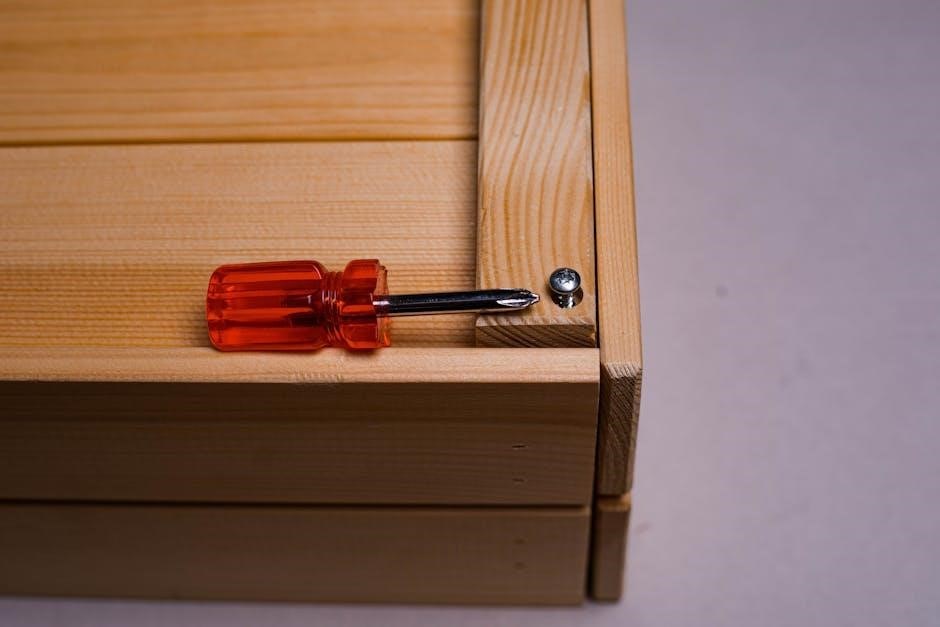
Safety Considerations and Best Practices
Always handle electrical components with caution, ensuring proper grounding and insulation. Follow safety guidelines to prevent shocks or damage. Use appropriate tools and verify connections before powering up.
Handling Electrical Components Safely
Handling electrical components safely is crucial to prevent injuries and ensure reliable installation. Always disconnect power before starting work. Use insulated tools to avoid shocks. Verify circuit voltage with a multimeter. Keep the work area clean and dry to prevent accidents. Ensure proper grounding of all components. Avoid touching live wires or terminals. Wear protective gear like gloves and safety glasses. Follow the manufacturer’s guidelines and local electrical codes. Double-check connections before restoring power. Never bypass safety features or skip precautions, as this can lead to serious risks. Proper handling ensures a safe and efficient installation process for the Ribu1c relay.
Ensuring Proper Grounding and Insulation
Proper grounding and insulation are critical for safe and reliable operation of the Ribu1c relay. Ensure all components are grounded according to local electrical codes and manufacturer guidelines. Use appropriately rated wires for grounding to prevent voltage drops and ensure safety. Insulation must be intact and meet the required specifications to avoid short circuits. Regularly inspect wires and connections for signs of wear or damage. Use high-quality insulation materials to protect against environmental factors like moisture and temperature fluctuations. Test insulation resistance with a multimeter before and after installation. Proper grounding and insulation not only enhance system performance but also prevent electrical hazards, ensuring long-term reliability and safety. Always follow best practices for insulation and grounding to maintain optimal functionality.
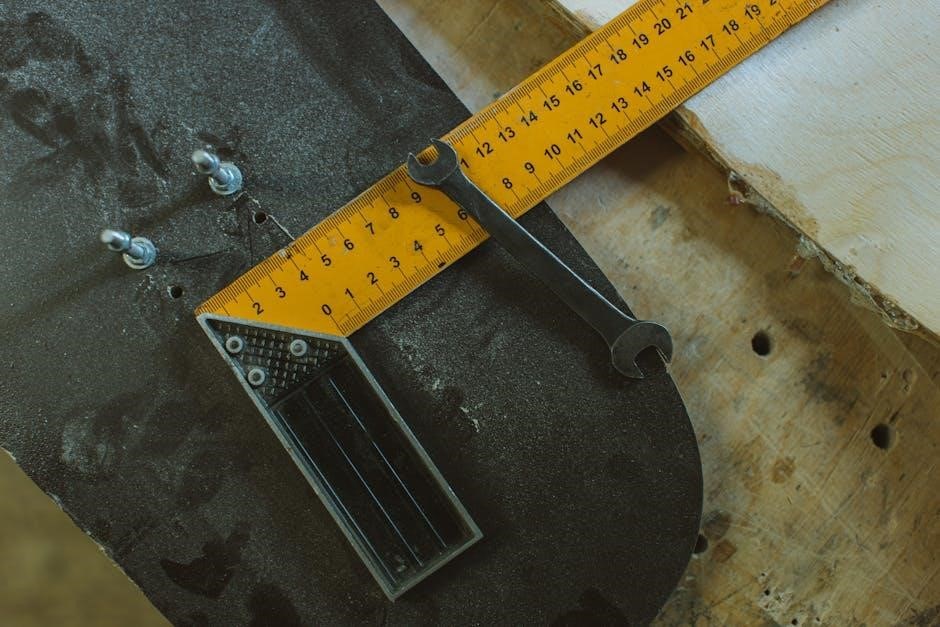
Troubleshooting Common Issues
This section provides guidance for diagnosing and resolving common problems with the Ribu1c relay, such as the relay not turning on, incorrect wiring, or overheating issues. Regular inspections and adherence to troubleshooting steps ensure optimal functionality and prevent potential failures.
Relay Not Turning On
If the Ribu1c relay fails to activate, ensure the power supply is correctly connected and within the specified voltage range. Verify that the control signal from the thermostat or control system is present and functioning properly. Check for loose or incorrect wiring connections, as this is a common cause of the issue. Inspect the relay’s coil for any signs of damage or malfunction. Consult the wiring diagram to confirm that all connections match the recommended configuration. If the problem persists, test the relay with a separate power source to isolate the issue. Always ensure proper grounding and insulation to avoid electrical interference or short circuits. Regular maintenance and inspections can help prevent such issues and ensure reliable operation.
Incorrect Wiring or Connections
Incorrect wiring or connections are common issues that can prevent the Ribu1c relay from functioning properly. Always refer to the wiring diagram provided in the manual to ensure all connections are accurate. Verify that the control and load wires are connected to the correct terminals, as specified for your application. Miswiring the coil or load terminals can lead to malfunction or damage. Check for loose connections, as they can cause intermittent operation. Ensure the relay is properly grounded to avoid electrical interference. If using a thermostat, confirm that the C-wire (common wire) is correctly connected, as some systems require it for proper operation. Double-check that the voltage supplied matches the relay’s rated specifications. If unsure, consult a licensed electrician to avoid potential hazards or system damage. Regularly inspect connections to prevent issues related to wear or corrosion. Proper wiring ensures reliable performance and safety. Always follow the manufacturer’s guidelines for optimal results.
Overheating or Noise Issues
Overheating or noise issues with the Ribu1c relay can indicate improper installation or environmental factors. Ensure the relay is mounted in a well-ventilated area, away from direct sunlight or high-temperature sources. Check for loose connections, as they can cause electrical resistance and generate heat. Verify that the relay is rated for the current and voltage in your application. Noise, such as buzzing or humming, may result from coil vibration or improper wiring. To minimize noise, ensure the relay is securely mounted and consider using noise-suppressing capacitors if recommended. If overheating persists, inspect for dust buildup or excessive ambient temperature. Always follow the manufacturer’s guidelines for operating conditions. If issues remain unresolved, consult the manual or contact a professional for assistance. Proper maintenance ensures long-term reliability and safety. Regular inspections can prevent such issues from escalating. Addressing these concerns promptly helps maintain optimal performance.
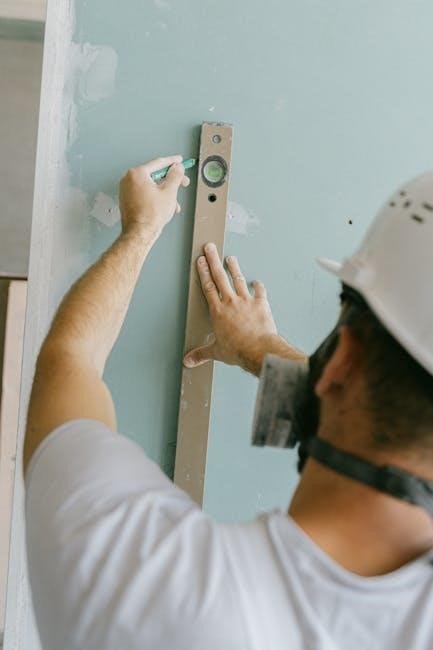
Maintenance and Upkeep
Regular maintenance ensures the Ribu1c relay operates efficiently. Clean the relay and inspect for dust or wear. Replace any faulty components promptly to maintain performance. Adhere to safety guidelines during upkeep to prevent damage and ensure long-term reliability.
Cleaning andInspecting the Relay
Cleaning and Inspecting the Relay
Regular cleaning and inspection of the Ribu1c relay are essential to ensure optimal performance and longevity. Begin by disconnecting power to the relay to avoid any electrical hazards. Use a soft, dry brush or a lint-free cloth to gently remove dust, dirt, or debris from the relay’s surface and terminals. Avoid using liquids or harsh chemicals, as they may damage the components. Inspect the relay for signs of wear, corrosion, or overheating. Check the terminals for secure connections and ensure no wires are loose or frayed. If you find any damaged or corroded parts, replace them immediately. Proper maintenance ensures reliable operation and prevents potential failures. Always follow safety guidelines during the process.
Replacing Faulty Components
Replacing faulty components in the Ribu1c relay ensures reliable operation and prevents system failures. Start by disconnecting power to the relay to avoid electrical hazards. Remove the relay from its mounting bracket and carefully disconnect the wires from the terminals. Inspect the relay for visible damage, such as burn marks or corroded contacts. If a component is faulty, replace it with an exact manufacturer-recommended part to maintain compatibility. Reinstall the relay, ensuring all connections are secure and properly insulated. Finally, reconnect the power and test the relay’s operation to confirm functionality. Regular replacement of faulty components extends the lifespan of the relay and ensures optimal performance in your control system.
Completing the Ribu1c installation ensures reliable performance and long-term functionality. By adhering to the manual’s guidelines, you achieve a seamless setup, guaranteeing safety and optimal system operation.
Final Checks and Verification
After completing the installation, perform final checks to ensure everything functions correctly. Verify that all connections are secure and match the wiring diagram. Test the relay operation by simulating real-world scenarios, such as turning the system on and off. Check for any unusual noise, overheating, or malfunction. Ensure the relay responds appropriately to control signals from thermostats or other devices. Inspect the mounting for stability and proper grounding. Review safety precautions to confirm compliance with electrical standards. Finally, document the installation for future reference and maintenance. These steps ensure long-term reliability and optimal performance of the Ribu1c relay in your system.
- Confirm all connections are secure and correctly wired.
- Test relay operation under various conditions.
- Inspect for proper grounding and insulation.
- Document the setup for future maintenance.
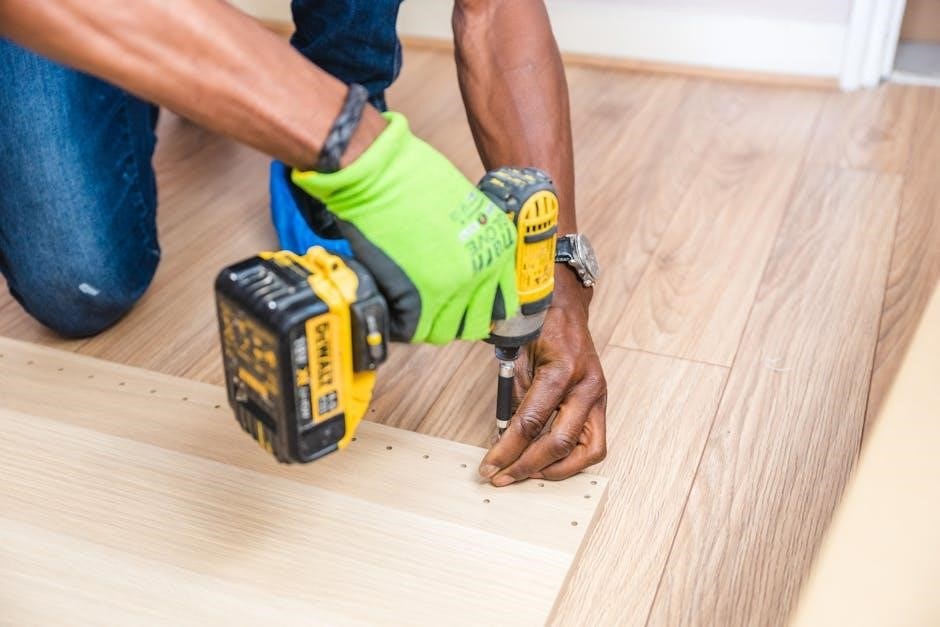
Long-Term Reliability and Performance
The Ribu1c relay is designed to deliver long-term reliability and consistent performance in various control systems. Its high-quality materials and robust construction ensure durability, even under heavy usage. Proper installation and regular maintenance, as outlined in this manual, help prevent issues like overheating or electrical noise. The relay’s SPDT configuration and versatile compatibility make it a reliable choice for diverse applications, from HVAC systems to industrial controls. Over time, the Ribu1c retains its efficiency, providing stable switching and consistent operation. By following the guidelines in this manual, users can ensure the relay continues to perform optimally, minimizing downtime and extending its service life.
- High-quality materials ensure long-lasting durability.
- Proper maintenance prevents common operational issues.
- Consistent performance in diverse control systems.
- Reliable switching and minimal downtime.

